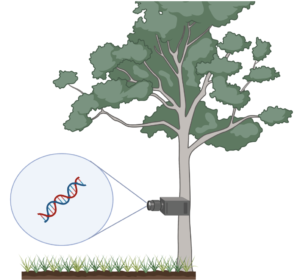Over the last decade, aquatic eDNA sampling has evolved from a research concept into a routinely employed tool for academic, industrial, and government entities to gather species data for biodiversity monitoring and environmental assessments. To meet the increasing demand for data, a new global industry of eDNA service providers is emerging. With solid workflows established to process water samples, eyes are now turning to dry land. Terrestrial sources of eDNA such as soil, scat, and swabs can be used to collect highly localised data, but a need exists to capture broader assessments akin to what can be achieved with water sampling.
In surveying terrestrial communities more broadly, airborne eDNA (airDNA) sampling has recently proven effective. Particles released or shed by terrestrial organisms can travel as aerosols and be picked up and detected as airDNA. AirDNA is well-established as a method of surveying microbes and a small but growing number of studies have recently showcased detection of plants and animals. Thus, bioaerosols have the potential to contribute broad terrestrial community composition data.
While airDNA stands to deliver new streams of ecosystem data, the technology faces substantial hurdles. My team is currently addressing key challenges impeding more rapid uptake of airDNA technology:
1 – Collection standardisation and throughput
A variety of airDNA collection platforms have been developed and are currently in use by researchers around the world. These platforms vary in their mechanism of action, cost, collection volume, portability, and availability. One thing these platforms have in common is their incompatibility with high-throughput processing, which inhibits eDNA service providers from offering airDNA sampling support.
2 – False negative reduction
There remains a large degree of uncertainty in how long eDNA persists in terrestrial environments. This uncertainty limits confidence in “absence” results, especially for rare species, which are often targeted in conservation and biosecurity applications.
3 – Clear deployment guidelines
No guidelines currently exist to support sampling design for a given target species or ecosystem. AirDNA studies are currently needing to devise bespoke sampling strategies (platform selection, placement, deployment duration, deployment timing, etc.) for every application, thus slowing adoption.
